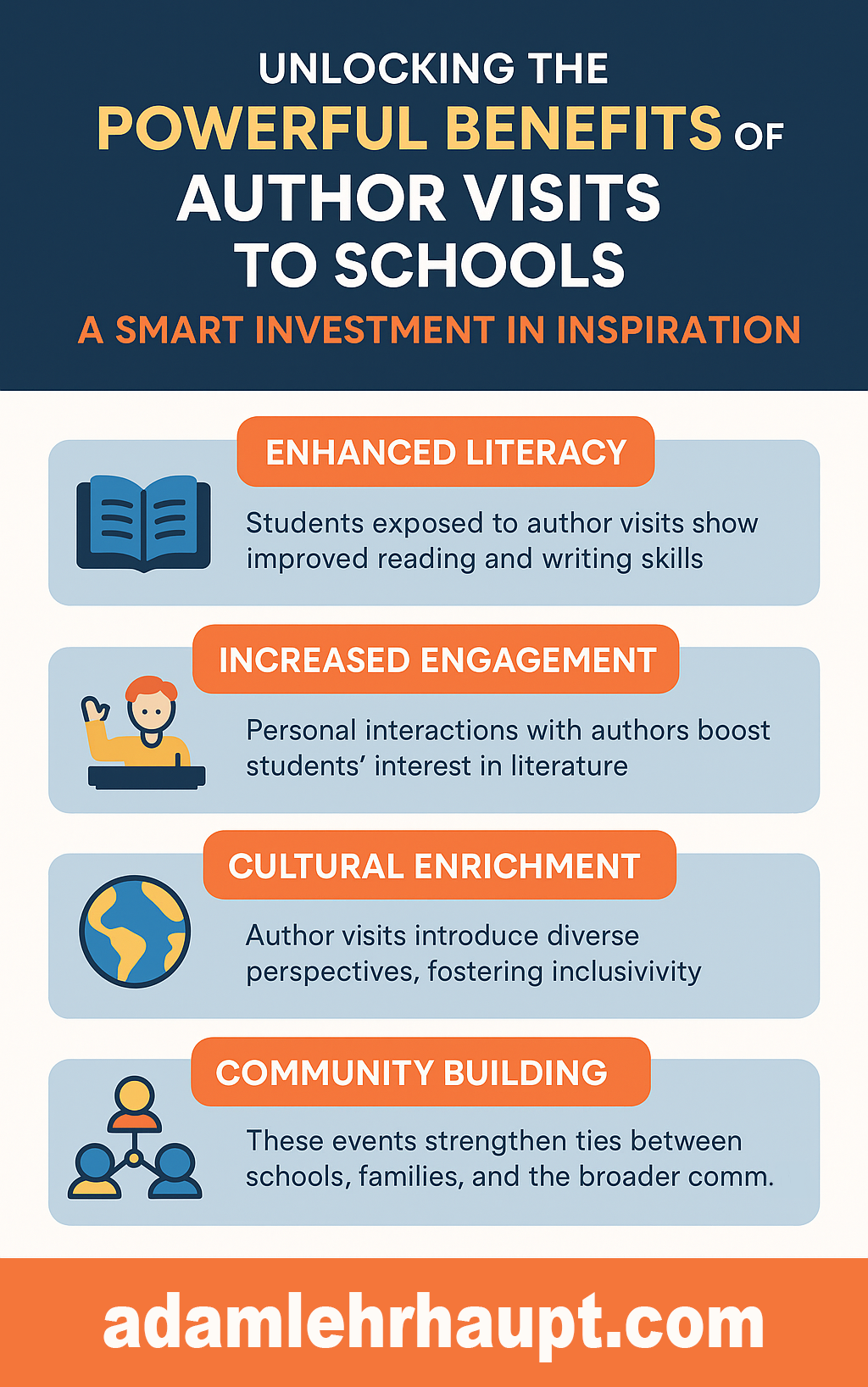Is an Author Visit Worth It?
Ever found yourself pondering, “Is bringing an author to our school a wise investment?” You’re not alone. Many educators and administrators grapple with this question, and determining the benefits of author visits, especially when budgets are tight and expectations high.
But here’s the scoop: Author visits offer more than just a break from routine—they’re catalysts for inspiration, engagement, and lasting educational impact.
📌 TL;DR — What You’ll Learn
Benefits of author visits include boosting literacy, increased engagement, and community building. Here’s some more of the benefits I cover below:
- Enhanced Literacy: Students exposed to author visits show improved reading and writing skills.
- Increased Engagement: Personal interactions with authors boost students’ interest in literature.
- Cultural Enrichment: Author visits introduce diverse perspectives, fostering inclusivity.
- Community Building: These events strengthen ties between schools, families, and the broader community.
You’ll also get a few free resources (yay!), and the complete planning guide that’ll make your PTA president weep with joy. Or at least stop texting you at 11 p.m.
📈 Quantifiable Benefits of Author Visits
1. Boost in Literacy Skills
This is one of the biggest benefits of author visits. Studies indicate that students who participate in author visits are twice as likely to read above their expected age level compared to peers who haven’t had such experiences.
Okay, so maybe I’m not sprinkling magic dust on vocabulary tests (yet), but the data doesn’t lie—something magical happens when kids realize authors are real people and not just names on shiny book covers. Meeting a live, in-the-flesh writer turns the idea of reading from “that thing we have to do” to “that thing I GET to do.” It’s like flipping a switch from passive reader to passionate explorer—and all it takes is one really great visit to light that fire.
🧠 Want more evidence to win over a reluctant administrator? Check out How to Fund Your Author Visit (Without Going Broke).
2. Enhanced Reading and Writing Enjoyment
This is one of those benefits of author visits that just makes sense. Children who have met authors report higher enjoyment in reading (68.2% vs. 47.2%) and writing (43.9% vs. 32.4%) than those who haven’t.
And let’s be honest—those percentages? That’s not just stats. That’s the sound of reluctant readers picking up pencils and saying, “Okay, fine, I’ll write the next chapter.” When a student hears how a book idea was born or sees doodles from a first draft, it makes the process feel less intimidating and more possible. Suddenly, reading and writing aren’t just “school stuff.” They’re creative superpowers. Capes optional.
🎯 Want grade-specific ideas? Try these 5 Author Visit Activities by Grade Level.
3. Positive Impact on Reluctant Readers and Disadvantaged Students
In this study from The Literacy Trust, 58.9% of students who had an author visit enjoyed reading in their free time, compared to just 36.1% without such visits.
Now imagine this: a student who doesn’t enjoy books at home gets to not only meet an author—but actually ask them questions. For many kids, especially those in under-resourced communities, this isn’t just a cool event. It’s a seismic shift. It’s proof that their voice, their ideas, their imagination matters. You want to close opportunity gaps? Start with story time.
🎧 Want to hear how picture books spark this kind of change? Don’t miss the Picture This Podcast.
💡 Measuring ROI: Beyond Intangibles
To assess the true ROI and benefits of author visits more concretely, consider the following metrics:
- Pre- and Post-Visit Surveys: Gauge changes in students’ attitudes toward reading and writing.
- Library Circulation Data: Monitor any uptick in book checkouts following an author visit.
- Writing Samples: Evaluate improvements in students’ writing quality and creativity.
- Attendance and Participation: Track attendance rates and participation in reading-related activities post-visit.
And hey, if you’re thinking, “But how do I prove this worked to my principal/PTA/budget overlords?”—this is your answer. Author visits aren’t just about feel-good moments (though those are awesome). There are concrete benefits of author visits. They’re data-rich, engagement-packed, academic rocket boosters. So yes, go ahead and get that spreadsheet started. I’ll wait.
🎁 Bonus Benefits to Highlight
- Cultural Exposure: Authors often share diverse backgrounds and experiences, broadening students’ worldviews.
- Career Inspiration: Meeting a professional writer can inspire students to consider careers in writing, publishing, or related fields.
- Community Building: Author visits can foster a sense of community, uniting students, teachers, and parents around a shared literary experience.
And if all that sounds a little too kumbaya for you, don’t worry—we also bring the drama. The laughs. The occasional book-themed sock fashion show. Author visits aren’t just educational. They’re events. They make schools feel like a place where anything can happen—and often does. Let’s just say the buzz doesn’t wear off when the books get packed up.
📥 Downloadable Resources
To maximize the impact of author visits, consider utilizing the following free resources:
- 📘The complete Guide to Hosting Successful Author School Visits It’s your all-in-one planning, funding, and magic-making playbook. You can get it FREE just by signing up for my newsletter.
- ✏️ Creative Writing Prompts Pack Designed to spark wild ideas, strong opinions, and totally weird (but awesome) stories.
- 🎨 Author Visit Activity Sheets Drawing prompts, vocabulary lists, and reflective journaling pages perfect for pre- or post-visit engagement.
Not to brag, but these are the kinds of teacher-friendly tools that make you look very organized with minimal effort. You’re welcome.
🧠 Conclusion: The Lasting Impact
Investing in an author visit transcends the immediate excitement of the event. It cultivates a culture of reading, inspires budding writers, and connects the school community through shared experiences.
And sure, there may be glitter. Maybe even a kazoo solo. But what you’ll really walk away with is something better—students who can’t wait to read, write, and tell their own stories.
Ready to bring this kind of magic to your school? Book a Visit with Adam Lehrhaupt or sign up for my newsletter to Download the Complete Guide to get started.
❓ FAQ: Your Top Author Visit Questions Answered
When should I start planning an author visit?
Ideally, 6–12 months in advance to ensure availability and thorough preparation.
How much do author visits typically cost?
Costs vary based on the author’s experience and travel requirements. And many, including me, will work with you to create something that fits in your budget. It’s best to contact the author directly for specific rates. (Psst… I’m friendly. And you can contact me here.)
Can author visits be conducted virtually?
Absolutely! Virtual visits can be a flexible and cost-effective alternative if you can’t bring an author in to your school.
Do we need to purchase books for the visit?
While not usually mandatory, offering books for sale can enhance the experience and provide students with lasting mementos.
How can we prepare students for the visit?
Engage students with the author’s work beforehand, encourage questions, and involve them in related activities. And check out some of my ideas in this post on how to create an author visit they’ll never forget.
What if our school has a limited budget?
You’re not alone. Lot’s of schools are working on very limited budgets, especially for activities like author visits. Explore grants, community sponsorships, or virtual visit options to accommodate budget constraints. I have a whole post of ways you can help fund an author visit. Start here >>
What are the key elements of a successful author visit?
Clear communication, thorough preparation, student engagement, and post-visit follow-ups contribute to a memorable experience. Get all the tools you need in my complete Guide to Hosting Successful Author School Visits by signing up for the newsletter.




